Instructions for growing figs at home from a seed or sprout
Fig tree, ficus carica, fig - the name of the same plant. It is a fruit crop that produces tasty and healthy fruits with a dark purple shell. They are good fresh and in the form of dried fruits, as an addition to desserts, meat and fish dishes.
The Mediterranean is considered the birthplace of figs. In our country, a heat-loving plant outdoors is grown only in regions with a southern climate. But as a houseplant, the fig tree is cultivated throughout Russia. How to grow figs at home so that it bears fruit, read the article.
The content of the article
Is it possible to grow figs at home
Growing figs at home it is quite possible. Even in nature, a compact fig tree rarely grows above 2-2.5 m. In a pot, the plant reaches a height of no more than 1-1.5 m... It can be made lower by shaping and pinching the growth point.
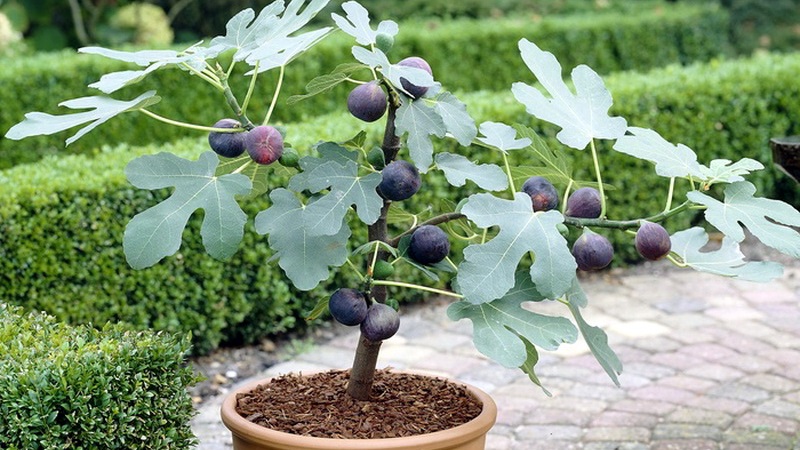
In order for a fig tree to not only grow in a pot on a windowsill as a green houseplant, but also bear fruit, it is important to choose the right variety. Fig trees are divided into three types.:
- requiring pollination;
- not requiring pollination (parthenocarpic);
- dispensing with spring pollination, but needing autumn (mixed).
For home cultivation, varieties are chosen that do not require pollination.... Also, gardeners recommend giving preference to undersized options. They have a neat crown and are easy to shape.
The best varieties of figs for growing at home are considered:
- Solar;
- Sochi 7;
- Kadota;
- Violet Sukhumi.
Other varieties will do, but if they require pollination, it will be extremely difficult to achieve fruiting. Tall varieties of fig trees require frequent shaping, are less enduring and more demanding in care.
Requirements for conditions of detention
When growing figs in an apartment, it is important to provide the plant with optimal conditions.... Otherwise, it will begin to fade, hurt, dry out and eventually die.
Suitable growing conditions:
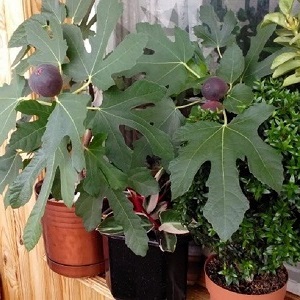 Temperature... Fig is a heat-loving plant. The optimum temperature for its cultivation from early spring to late autumn is + 25 ... + 27 ° C. The fig tree also grows at room temperature - + 20 ... + 22 ° C. In winter, when the fig tree has shed its leaves, the temperature is lowered to + 10 ° C. During winter dormancy, the tree can withstand temperatures down to 0 ° C.
Temperature... Fig is a heat-loving plant. The optimum temperature for its cultivation from early spring to late autumn is + 25 ... + 27 ° C. The fig tree also grows at room temperature - + 20 ... + 22 ° C. In winter, when the fig tree has shed its leaves, the temperature is lowered to + 10 ° C. During winter dormancy, the tree can withstand temperatures down to 0 ° C.- Humidity... Figs need high humidity. On average, the indicators should reach 75-80%. Hot, dry air emanating from heating devices is dangerous for wood. The plant is not placed near heaters and batteries. If it is indoors in the cold season, then use air humidifiers.
- Lighting... The optimal day length for figs during the growing season is 12 hours. However, lovers of exotic plants argue that it is not necessary to use additional lighting sources. It is enough to choose the right place for growing. Indoor figs do not tolerate the direct rays of the scorching sun, therefore it is recommended to shade it from 12 to 16 hours.
In summer, the plant has enough natural light.... It is placed near the south window, covered with a translucent curtain, or on the east window sill without additional protection from the sun.
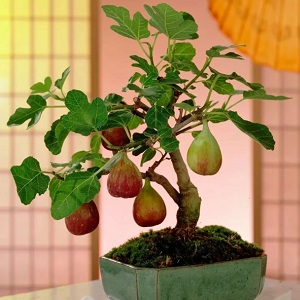 In the warm season, it is useful to take a potted plant into the garden or put it on the balcony.... Choose a place partially protected from the sun.
In the warm season, it is useful to take a potted plant into the garden or put it on the balcony.... Choose a place partially protected from the sun.
In spring and autumn, the plant should be on the southern windowsill... Closing the window with tulle is optional.
In winter, figs are taken out to a cool room.... It can be a glazed, frost-protected balcony or loggia, an unheated room or a window sill in the entrance (provided that the window is large and lets in a lot of light). It is advisable to place the plant near the southern windowsill.
Note! If at the beginning of spring or late autumn the plant stands on the window under which the heater works, you will need protection from hot dry air. To do this, lay a damp cloth on the battery, and make a side of insulating foil material at the edge of the window sill.
Planting figs
Cultivation of figs is possible in two ways: by seeds and cuttings... Most gardeners use the second method. It takes little time, is easy to execute and gives a guaranteed result, since the cuttings of the fig tree take root easily. The chance that a plant grown vegetatively will bear fruit is higher than that of a pitted fig.
Some lovers of exotic indoor plants are interested in the process of growing figs "from scratch" In addition, it is not always possible to get a cutting. In this case, seeds harvested from fruits are suitable. They have a low germination rate, and the seedlings obtained from them grow slowly.
Growing figs from a sprout
Before planting a fig sprout, it is important to select a suitable planting material. A branch is cut from a fruiting tree without traces of defeat diseases and pests.
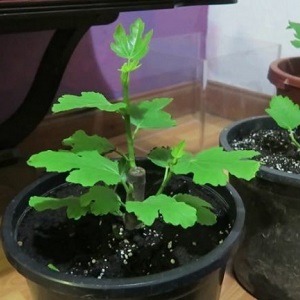 Such a distance retreat from the upper edge so that 3-4 axillary buds remain on the future cutting. The cut is made even. 2 cm recede from the lower kidney and cut at an angle of 45 °. If the branch is divided into several cuttings, then a distance of 1 cm is left from the upper bud to the cut.
Such a distance retreat from the upper edge so that 3-4 axillary buds remain on the future cutting. The cut is made even. 2 cm recede from the lower kidney and cut at an angle of 45 °. If the branch is divided into several cuttings, then a distance of 1 cm is left from the upper bud to the cut.
Any small container with holes in the bottom is suitable for rooting a cutting.... Plastic cut bottles or disposable cups are often used. The container is sterilized with boiling water or a dark pink solution of potassium permanganate.
Ordinary universal soil is also suitable as soil. Experienced gardeners recommend mixing it with sphagnum. The earth is also disinfected.
How to grow a seedling from a cutting at home in a pot:
- A drainage layer is poured onto the bottom of the container. The rest of the volume is filled with soil. The soil is moistened with warm water.
- The stalk is soaked for 30 minutes in a light pink solution of potassium permanganate. Shallow notches are made on the bark of the lower part of the branch (up to the bud). The branch is placed in a root formation stimulator for a day ("Heteroauxin", "Kornevin").
- The stalk is stuck into the ground along the second kidney. It is sprayed with water, covered with a bag or the top of a cut bottle, and placed in a warm, well-lit place.
The plant takes an average of 2-4 weeks to root.... The fact that the fig has taken root is evidenced by the formed leaves.
Note! Some gardeners root the cuttings in water, and only then transplant them into the ground.
Before the cutting takes root, it watered as the soil dries, ventilated for 15 minutes daily, sprayed with warm water. After rooting, the duration of airing begins to increase, gradually accustoming the plant to room temperature. When the duration of airing reaches a day, the greenhouse is dismantled.
Propagation of figs by seeds
Fig seeds are obtained from fresh fruitsbought at the supermarket. They should be fully ripe, have a purple tint, and the correct shape. It is important that there are no spots, rot, holes and other signs of infection with diseases and pests.
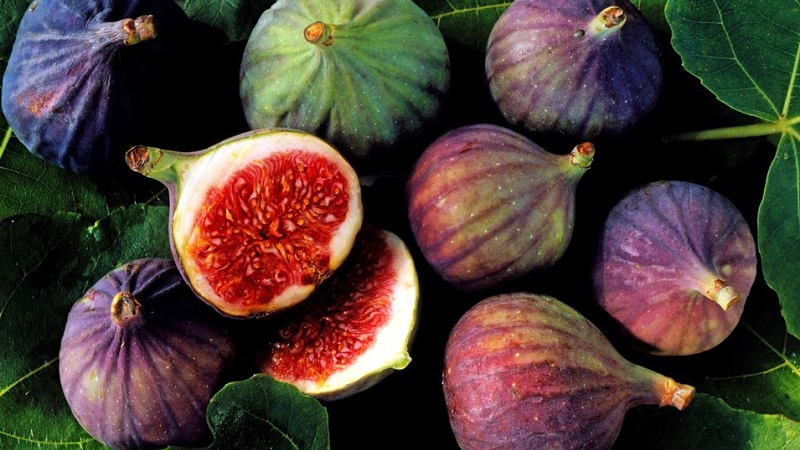
The ripe fruit is cut and seeds removed... They are washed in warm water, removing the pulp. Then the seeds are dried within 24 hours.
Note! Do not store fig seeds for long. This reduces their germination. It is better to plant planting material immediately after collection and preparatory procedures.
Sow the seeds of the fig tree in a shallow common container with drainage holes in the bottom. The containers are disinfected before planting.
Purchased universal soil is suitable for germinating seeds. or a mixture of garden soil, lowland peat and sand. The soil is disinfected with a dark pink solution of potassium permanganate.
Instructions for beginner gardeners, how to plant fig seeds:
- The container is filled with drainage and soil so that 3 cm remain free to the edge. The soil is moistened with warm water.
- The seeds are planted at a distance of 2 cm from each other. They are planted to a depth of 2-3 cm.
- The soil is moistened with warm water from a spray bottle. The container is covered with foil and placed in a warm place. Ventilate daily for 15 minutes, moisten the soil as it dries from a spray bottle.
After the shoots appear, the airing time is gradually increased and brought to a day. Then the greenhouse is dismantled.
When 2-3 true leaves appear, the plants dive into individual containerschoosing the strongest specimens. It is important that the volume of the pot is no more than 0.5 liters, and there are drainage holes in the bottom of the containers. When transplanting, the root collar is not buried.
Interesting on the site:
Fig care rules
In order for the plant to develop correctly and not hurt, it must be properly looked after:
- Watering... The soil is moistened every other day. It is important to ensure that the soil does not dry out, but the moisture does not stagnate in it. Some growers use bottom watering, constantly adding room temperature water to the pan under the pot. The procedure is carried out in the morning or evening when the sun is inactive.
- Spraying... Figs are sprayed daily in the morning or in the evening with warm, settled water. This procedure not only helps maintain optimal humidity levels, but also prevents dust mites.
- Loosening... At least 1 time a week, the soil is loosened. This is necessary for the destruction of the earth crust, which interferes with normal root air exchange and contributes to the stagnation of fluid in the roots.
- Top dressing... They begin to apply in early spring, even before the buds swell. Use nitrogenous fertilizers. After swelling of the buds and the formation of leaves, potassium-phosphorus and organic ones alternate. Top dressing is applied on average 1-2 times a month.
- Formation... When the plant reaches a height of 30 cm, pinch the central trunk. At each level, 3-4 of the strongest skeletal branches directed in different directions are left. All shoots growing inward are removed. The branches are shortened to form a neat crown.
- Sanitary pruning... The procedure is carried out annually in the fall. Remove dry, damaged and old branches.
- Transfer... When the roots fill the pot, the figs are transplanted into a new larger container. This is done by transshipment. The plant is removed from the pot along with a lump of earth. It is rearranged into a new container, and the missing volume is filled with soil. It is impossible to immediately plant a plant in a large container. It will not form properly and will not bear fruit.
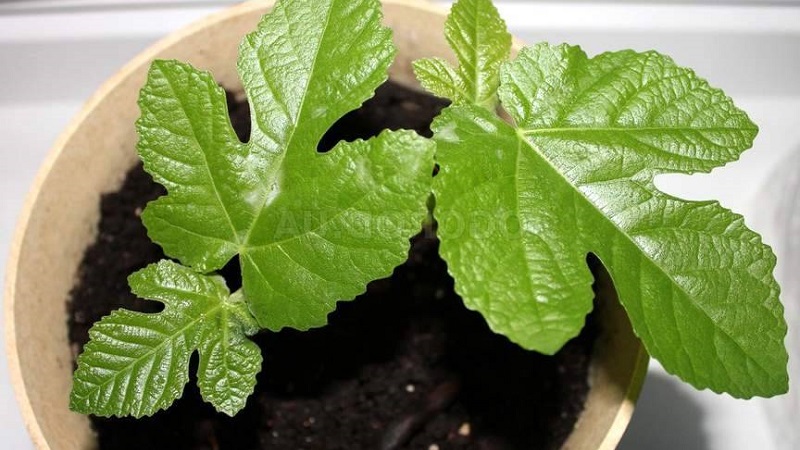
Features of winter care
During wintering, the care of figs changes, since during this period the plant is at rest. When the plant has shed its leaves, it is placed in a colder room. Top dressing is stopped. The frequency of watering is reduced to 3-4 times a month.
Flowering and fruiting
Figs grown from seeds begin to bloom and bear fruit 2-3 years after planting... If a florist decides to breed a plant with seeds, then he will receive the first harvest only for 4-5 years.
During fruiting, it is important shape the tree correctly. No more than 2-3 fruits are left on each branch. The rest are removed.
Often gardeners complain that although the fig tree bears fruit, it does not bloom... This is actually a feature of the fig tree. At home, its fruits are able to tie on a tree without leaves.
If figs don't bear fruit at allmost likely a cultivar was chosen that requires pollination. To solve the problem, a branch of a fruiting fig is grafted onto the plant.
Protection against diseases and pests
At home, figs infest diseases and pests much less often than in the garden. However some problems when growing it may arise:
- Spider mite... A small black or red insect that feeds on the sap of the plant leads to its wilting. You can find the pest by the cobweb on the back of the leaves. The main cause of spider mite infestation is dry indoor air. To deal with the problem, the fig tree is washed in the shower and then sprayed with soapy water.
- Coral spot... A fungal disease that manifests itself as reddish spots on the shoots of figs. If a problem is found, all affected parts are removed, and the plant is sprayed with a solution of copper sulfate.
Other possible growing problems and solutions
Novice gardeners face a number of problems when growing indoor figs:
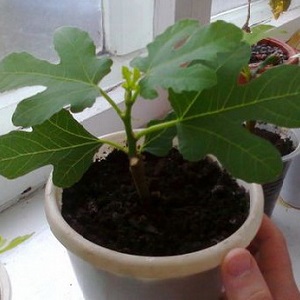 Leaves do not fall off in winter. Usually, figs are taken out into a cool room after leaf fall. If the leaves do not fall from the crown, the fig tree is taken out into a cool room at the end of autumn. A change in temperature will provoke leaf fall.
Leaves do not fall off in winter. Usually, figs are taken out into a cool room after leaf fall. If the leaves do not fall from the crown, the fig tree is taken out into a cool room at the end of autumn. A change in temperature will provoke leaf fall.- The leaves began to turn yellow and fall off. This happens if the plant is in a draft, it is watered with cold water, or the air in the room is too dry. To rectify the situation, all negative factors are eliminated.
- The tree began to turn yellow and wilt after being sent to winter, moving to the garden or back to the house. This happens with a sharp change in temperature. To prevent this from happening, the plant is pre-hardened.
Conclusion
Fig is a heat-loving plant, which is problematic to grow outdoors in our country. But it feels comfortable in a pot at home.
With proper care, the fig tree will delight not only with beautiful leaves, but also with regular fruiting up to 2 times a year. The main thing is to choose a variety that does not require pollination and provide a comfortable living environment.